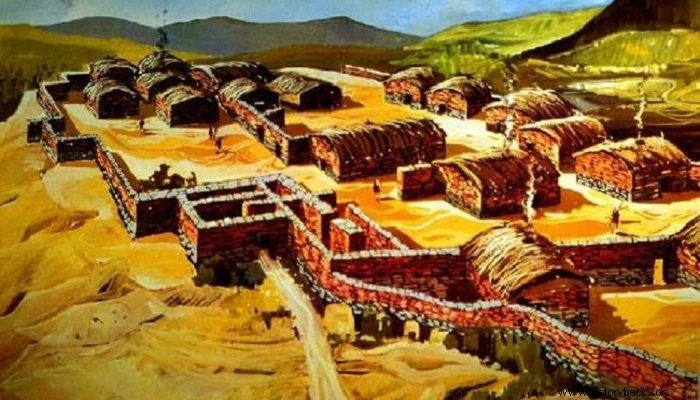
The Greek area was inhabited hundreds of thousands of years ago. However, the first findings of weapons are much later and date back to the Middle Paleolithic period. These finds concern stone arrowheads, javelins and spears. The specific weapons were clearly used in hunting, but also apparently in the various conflicts between the food-gathering people of the time.
Apparently there were other melee weapons, such as clubs, which were not preserved, but the results of their use on human remains were preserved, as evidenced by skeletal finds of the time. In these times we cannot talk about the existence of armies. There were simply armed groups organized on a tribal basis. The first armies were born when the wandering groups of hunters settled permanently in one place and began to cultivate the land.
Permanent settlement – rulers – armies
It was the agricultural revolution of the Mesolithic – early Neolithic period itself. which created the concept of property, dictated social stratification and ultimately led to the formation of the first armies in history. The archaeological findings are an irrefutable witness to this truth. In the ruins of the first European city, Sesklos (5800 – 4400 BC), the excavators Chr. Tsountas and D. Theoharis discovered at the top of the acropolis, the "ruler's palace".
The ruler should have an armed guard, both for the protection of himself and the citadel, on which the storehouses of the city's products were located, and for the protection of the citizens, who constituted the productive capital of the ruler.
If we calculate, based on the number of houses, the number of inhabitants of the city between 2,500 and 4,000 people, statistically, we can calculate that the total military force could not exceed 800 - 1000 men. Of these, a percentage of the order of 10% would perhaps constitute the permanent armed force of the ruler.
The above statistical model is based both on the calculations of Professor D. Theoharis, about the population density of the city of Sesklos, and on Sumerian models similar to Sesklos.
Weapons
In this particular period the weapons in use did not differ substantially from their Paleolithic counterparts. They were distinguished in ecebola and agameha. The ecvils were the bow, the javelin and the sling. The bat (headbreaker), the spear and the manual were ranked in the fights.
The points and blades of these weapons were originally made of finely worked stone, usually obsidian (obsidian), a glassy rock. Obsidian blades, perfectly polished, can slice through human flesh as easily as a metal one. Obsidian does not have the same impact resistance of course and is unable to penetrate armor. However, from the middle of the 5th millennium, the processing of metals began in Greece.
Shields of the time have not been saved, perhaps because they were made of perishable materials. However, it is possible that there were some prototypes – the first shields, of which prototypes have survived, consisted of an animal skin stretched over a wooden frame. As for the head-breakers, examples of their pointed heads, which were made of stone, have been preserved.
Slingshot projectiles, stone, covered with a layer of clay, have also been discovered. When they hit hard ground the clay broke and its fragments acted as "shards". The same practice was followed centuries later by the Romans, who covered the projectiles of their catapults with a layer of clay.
However, the great revolution took place at the beginning of the 4th millennium, when the inhabitants of Greece began to work with copper initially, and later with brass. Weapons made of the durable metal were clearly more effective.
Horse - cavalry
However, at that time – about 3000 BC. – the second military revolution also took place which changed the form of military conflicts until the 19th century AD. It was the introduction of horses into the armies of the time. The first evidence comes from the Sumerians of Mesopotamia and concerns two-wheeled initial and four-wheeled war chariots, which were drawn by two to four onagers.
We do not know exactly when the horse began to be used as a means of warfare by the inhabitants of Greece. The domestication of the horse and the discovery of the wheeled chariot gave birth to a new weapon, the cavalry. The chariot was the ultimate weapon in plains, against infantry drawn up in loose order. But it became more effective when the warrior on it was equipped with a long spear.
So a warrior equipped with such a weapon could easily hit opponents equipped with shorter weapons at a safe distance. In fact, if the warrior in question also rode a chariot, then his tactical advantage was multiplied thanks to the speed and flexibility of the chariot.
Of course both owning and maintaining a chariot and raising at least four horses per chariot cost a lot. So only the respective ruler and his followers could be charioteers. The possession of chariots and horses further widened the social gap between the ruler and his subjects , facilitating the transition to the new age that followed, the "heroic", as it has been established to be called, while allowing the aristocracy of arms to reach the height of its power.
On the other hand, the various rulers saw that they had to create the antidote against the advances of enemy tanks. For this reason they also equipped the infantry with long spears.
